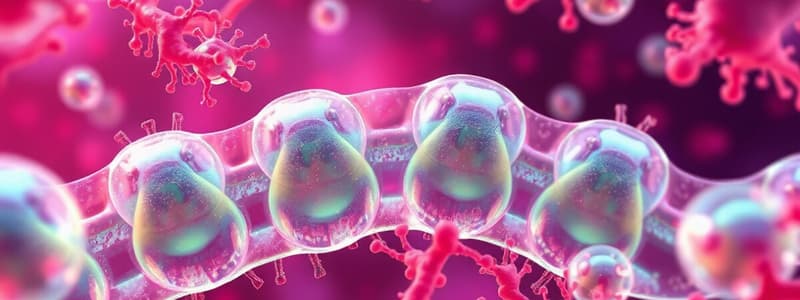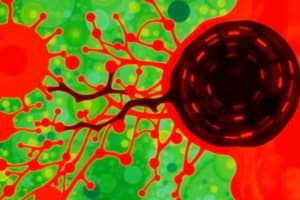Podcast
Questions and Answers
Which characteristic differentiates bacteria from archaea?
Which characteristic differentiates bacteria from archaea?
- Size of the organism
- Reproductive method
- Cell wall composition (correct)
- Presence of a nucleus
What is the main structural component of fungal cell walls?
What is the main structural component of fungal cell walls?
- Protein
- Peptidoglycan
- Cellulose
- Chitin (correct)
Which type of microorganism is characterized as noncellular and unable to reproduce independently?
Which type of microorganism is characterized as noncellular and unable to reproduce independently?
- Bacteria
- Viruses (correct)
- Fungi
- Protozoa
Which of the following groups includes microorganisms that can perform photosynthesis?
Which of the following groups includes microorganisms that can perform photosynthesis?
What type of microbes are classified under acellular organisms?
What type of microbes are classified under acellular organisms?
Which domain includes both prokaryotic and eukaryotic organisms?
Which domain includes both prokaryotic and eukaryotic organisms?
What is the primary focus of bacteriology?
What is the primary focus of bacteriology?
Which sub-discipline of microbiology primarily studies helminths and their diseases?
Which sub-discipline of microbiology primarily studies helminths and their diseases?
Which of the following classifications does not include organisms based on ribosomal RNA sequences?
Which of the following classifications does not include organisms based on ribosomal RNA sequences?
Which technique involves deliberately altering the genetic makeup of organisms?
Which technique involves deliberately altering the genetic makeup of organisms?
Flashcards
Microbiology definition
Microbiology definition
The study of microscopic organisms, microbes
Microorganism size
Microorganism size
Too small to see without a microscope
Cellular Microbes
Cellular Microbes
Living microorganisms with cells; e.g., bacteria, fungi, protists
Bacteria characteristics
Bacteria characteristics
Signup and view all the flashcards
Archaea characteristics
Archaea characteristics
Signup and view all the flashcards
Fungi characteristics
Fungi characteristics
Signup and view all the flashcards
Protozoa characteristics
Protozoa characteristics
Signup and view all the flashcards
Algae characteristics
Algae characteristics
Signup and view all the flashcards
Acellular Microbes
Acellular Microbes
Signup and view all the flashcards
Virus characteristics
Virus characteristics
Signup and view all the flashcards
Multicellular Animal Parasites
Multicellular Animal Parasites
Signup and view all the flashcards
Prokaryotic vs. Eukaryotic
Prokaryotic vs. Eukaryotic
Signup and view all the flashcards
Helminths
Helminths
Signup and view all the flashcards
Bacteriology
Bacteriology
Signup and view all the flashcards
Mycology
Mycology
Signup and view all the flashcards
Parasitology
Parasitology
Signup and view all the flashcards
Virology
Virology
Signup and view all the flashcards
Immunology
Immunology
Signup and view all the flashcards
Microbial Taxonomy
Microbial Taxonomy
Signup and view all the flashcards
Biotechnology
Biotechnology
Signup and view all the flashcards
Genetic Engineering
Genetic Engineering
Signup and view all the flashcards
Domains
Domains
Signup and view all the flashcards
Bacteria (Domain)
Bacteria (Domain)
Signup and view all the flashcards
Archaea
Archaea
Signup and view all the flashcards
Eukarya
Eukarya
Signup and view all the flashcards




